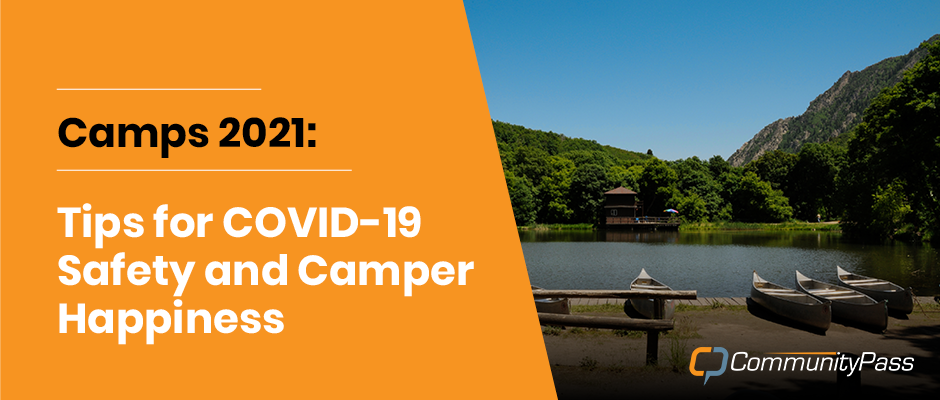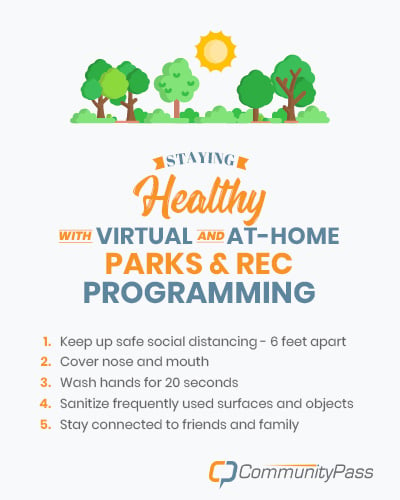Camps 2021: Tips for COVID-19 Safety and Camper Happiness
Updated

Very few organizations knew what to expect with the COVID-19 pandemic, let alone could have predicted its impact on camps during the 2020 season. Even the camps that did operate navigated the challenges in a completely novel and unprecedented way, whether by constantly shifting dates, implementing virtual activities to replace in-person ones, or drastically reducing capacity to comply with state and local guidelines.
Whether your own camp was open in 2020 or not, it’s time to look forward to 2021 and determine how you'll adapt to continued social distancing and the post-COVID landscape.
Moving forward with opening your doors and enrolling campers may seem daunting, but just because camp feels a little different doesn’t mean it’s not still a valuable and fulfilling experience for campers. After all, a week at camp is just the technology sabbatical that parents know their children desperately need.
We at CommunityPass specialize in recreation management, so we know firsthand the difficulties these programs have gone through over the past year. We understand the importance of taking proper safety precautions while still prioritizing camper happiness. To better prepare camp leaders like yourself, we’ve compiled these valuable tips:
- Promote a contactless experience with digital tools
- Plan outdoor and socially-distant programming
- Provide COVID-19 training programs for staff members
- Have a backup contingency plan
- Follow the CDC recommended guidelines
Ready to make this camp season the best it can be? Let’s dive in!
1. Promote a contactless experience with digital tools
We all know the now-standard rules of COVID-19 precautions—wash your hands, wear a mask, and stay at least 6 feet apart. To encourage as little physical contact as possible, it’s time to digitize some of your day-to-day tasks.
From registering for camp sessions, to checking in campers, and communicating with parents, there are technological solutions that can pivot these processes to be completely contactless. This way, you won’t have to constantly wipe down pens and spend unnecessary time face-to-face with others.
Use this list to ensure you have the essential digital tools for your next camp season:
- Online registration forms
- A searchable online camp session directory
- Online payment processing
- Tablets for camper check-in and check-out
- Integrated parent email and text communication tools
- Easy access to camper emergency information on tablets and other devices
- Program capacity management capability
- Digitally signed COVID-19 safety waivers
Make sure to share these safety measures with campers and families. Send out an email explaining the various steps your camp is taking to keep everyone protected during this season. You should also explain these protocols on your camp website, social media posts, and other marketing materials.
2. Plan outdoor and socially-distant programming
One silver lining of the COVID-19 pandemic has been an increased enjoyment of outdoor activities. More people are hiking, visiting parks, or simply walking around their neighborhoods than ever before.
These types of activities are not only great for our general health and wellbeing, but they can easily be socially distant!
For your camp programming, plan as many outdoor and socially distant activities as possible. Classic outdoor activities include swimming, kickball, water skiing, ropes course, and rock climbing.
If you’re still unsure of which activities to offer, take some insight from this article: “The key to planning a successful camp [program] is understanding what your community wants. The key to understanding what your community wants lies in your existing data!”
Take a look at past camp seasons and determine which types of activities were the most popular. You can even pivot your classic indoor classes like arts & crafts to the outdoors with some picnic blankets, tables, and chairs.
3. Provide COVID-19 training programs for staff members
It’s no secret that this camp year is different from most. Especially if you were closed the previous season, implementing specific COVID-19 guidelines and new procedures for staff members is critical.
Whether you’re providing guidance to new hires or longtime staff members, it’s beneficial to host specific training for the upcoming camp sessions. Take your old staff training programs and adapt them with health considerations from this past year.
This new training should include:
- Education on your state and local COVID-19 gathering guidelines
- All the current camp rules regarding COVID-19 safety, whether that’s 6-feet-social distancing or the enforced usage of masks
- Scenarios to teach staff what to do when campers don’t follow guidelines
- How to report broken rules
- What to do if a positive COVID-19 case (staff or camper) occurs
- Clear documentation on who has been vaccinated, if vaccines are currently widely available
You’ll want to make sure that everyone takes the same training. Maintain documentation within your management solution so that there’s a consistent level of knowledge across your staff and so team members can easily access your guidance whenever needed.
4. Have a backup contingency plan
Even with all the proper precautions in place and social distancing guidelines adhered to, it’s recommended to have a backup plan. As mentioned in the previous section, if a camper or staff member does have a positive COVID-19 result, there should be set procedures to follow.
Before the camp program starts, draft up a couple of email templates you can use and determine a refund policy in case of a COVID-19 exposure. You should also brainstorm logistics on whether or not everyone at the camp should go home or only those who have been exposed. This will make the entire experience much smoother if a positive case does occur. And if an employee is sick, make sure they know they can stay home and have other staff ready to fill in.
If someone has tested positive during the camp day itself, you need a plan to immediately separate those who have been exposed and those who have not. In fact, you can even use your digital attendance and check-in tools to help contact trace. But how?
Let’s use an example. Similar to camp managers, education leaders are in charge of a large number of moving bodies, including staff and students. If a positive case does occur, they can look to their afterschool management software data to comply with contact tracing efforts. Real-time attendance and class data can provide the information needed to determine which students and staff members have been in contact and when.
You and your camp staff can use your own management data similarly! Check which campers and staff have been in the same sessions and separate them accordingly. Once you’ve successfully traced the exposure, create a quarantine area for these individuals. This is also the time where you should contact the necessary family members.
5. Follow the CDC recommended guidelines
Above all, it’s best to keep up-to-date with the CDC’s recommended guidelines. They even have specific guidance for youth and summer camps that you should definitely refer to now and going forward.
Here are some of the important topics that the CDC has guidance on:
- When it’s appropriate to stay home
- Hand hygiene and respiratory etiquette
- Masks guidelines
- Supplies needed
- Cleaning and disinfecting protocols
- Ventilation guidelines
- Food service distribution
This CDC resource is the best way to keep everyone safe and ensure that campers have a good time. In addition to staff training and sending safety protocols to camp families, it’s helpful to also create signage and posters that communicate these messages throughout the camp itself.

We at CommunityPass created this COVID-19 resource that was distributed by park professionals last year. Your camp can emulate it for your own programming and safety signage materials.
Wrapping Up
This year may seem just like a repeat of the last, but it’s not. We’re all more experienced, know how to respond to emergencies better, and have the tools to set us up for a successful and safe camp experience. Remember to use digital tools to remain as contactless as possible and frequently check CDC guidelines to stay vigilant on COVID-19 recommended practices. Good luck and happy camping!
Joseph Oriente is the President and Founder of Capturepoint, creator of CommunityPass. Joe established Capturepoint in 1999 and launched CommunityPass in 2003, which was initially created to provide online registration and payment for a local town sports council that was overwhelmed with an increasing number of paper registrations. Since then Joe has been responsible for expanding CommunityPass nationally to become one of America’s most well-respected and complete online management solutions with registration, membership, and facilities software serving the recreation and school markets.
Written by circuitree